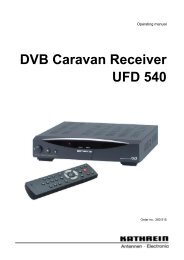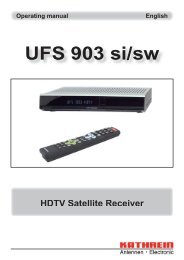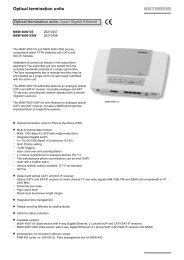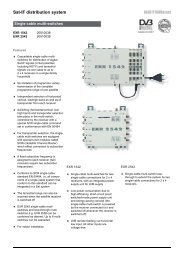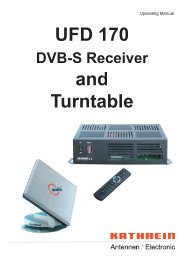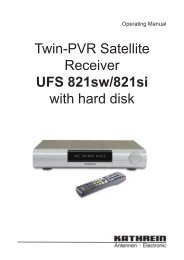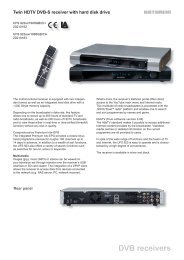9362576b, Operating Manual Twin-DVR Sat Receiver ... - Kathrein
9362576b, Operating Manual Twin-DVR Sat Receiver ... - Kathrein
9362576b, Operating Manual Twin-DVR Sat Receiver ... - Kathrein
Create successful ePaper yourself
Turn your PDF publications into a flip-book with our unique Google optimized e-Paper software.
Installation Menu<br />
However, the input frequency range for the receiver is in the range<br />
950 to 2150 MHz. The high frequencies are therefore converted into a<br />
lower frequency using the oscillator frequency (LO frequency/<br />
L.O. = LNB local oscillator). Different oscillator frequencies are used<br />
for the conversion depending on the satellite frequency range and the<br />
system type.<br />
For ASTRA and EUTELSAT reception systems, this is normally<br />
9.75 GHz (9750 MHz) for the lower frequency range (low band) and<br />
10.6 GHz (10600 MHz) for the upper frequency range (high band).<br />
Older reception systems still use a 10 GHz oscillator frequency in the<br />
low band range (which is not normally suitable for digital reception).<br />
The receiver generates the frequency to which it needs to adjust by<br />
subtracting the oscillator frequency from the satellite transmission<br />
frequency saved for each programme. You only have to set the<br />
oscillator frequency used by your reception system. Before chancing<br />
the LO frequency, you must therefore ascertain whether this is<br />
actually necessary.<br />
The oscillator frequencies listed above are the factory settings.<br />
Changing the Oscillator Frequency<br />
Press to move to the right-hand section of the LNB configuration<br />
menu. The setting for L.O. High is highlighted in colour. You can now<br />
use the number buttons to enter a new frequency appropriate for your<br />
system. Use the buttons to select L.O. Low and do the same.<br />
Press four times to exit the menu. This saves the set value.<br />
If you make an incorrect setting, you will see the following message:<br />
Operation<br />
Receiving Two <strong>Sat</strong>ellites<br />
Weak signal or no signal<br />
The factory setting is “On”.<br />
Under normal circumstances, the supply voltage should be turned on.<br />
If your receiver is connected to a multi-feed antenna, which is aligned<br />
with the HotBird satellites for example, you must change the receiver<br />
settings for the DiSEqC signal. This also applies to other satellites<br />
as well of course (DiSEqC = Digital <strong>Sat</strong>ellite Equipment Control).<br />
Different control signals are required to select the satellite signals. To<br />
date, the LNB supply voltage of 14/18 V and the 22 kHz signal<br />
(superimposed on the LNB supply voltage) have been sufficient for<br />
signal selection for most applications. These four switching signals<br />
allow you to switch between the horizontally and vertically polarised<br />
signals and between two satellites (multi-feed reception).<br />
To extend the frequency range to the 12 GHz range (high band) or for<br />
reception from more than two satellites, additional control signals are<br />
required for LNB actuation and signal selection.<br />
The DiSEqC signal is responsible for this. This is a special<br />
modulation of the existing 22 kHz signal.<br />
73




